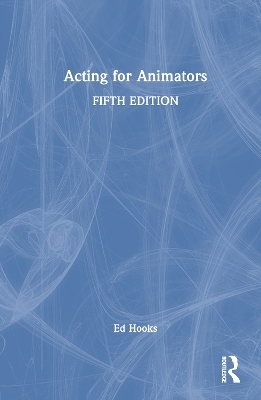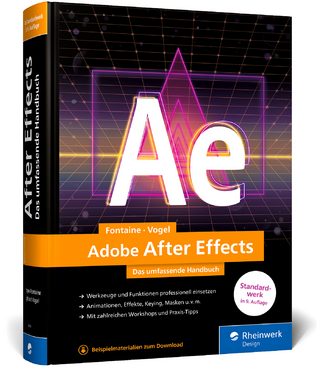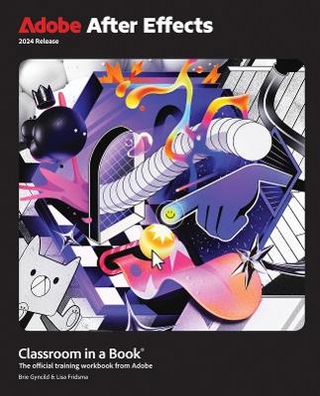
Acting for Animators
Routledge (Verlag)
978-1-032-26751-7 (ISBN)
Ed Hooks' essential acting guidebook for animators has been fully revised and updated in this fifth edition, capturing some of the vast changes that have affected the animation industry in recent years. Written specifically for animation professionals instead of stage and movie actors, this book provides an essential primer for creating empathetic and dynamic character performance and, in the process, shows how the strongest storytelling structure works.
Hooks applies classical acting theory – from Aristotle to Stanislavsky and beyond – to animation, as well as explaining scene structure, character development and the connections between thinking, emotion and physical action. Theory presented here applies to any and all character animation regardless of style or animation technique. Whether your project is stop-motion, 2D, 3D or a blend of techniques, audiences are audiences are audiences, and they have shown up at the theater or cinema so they can experience and enjoy your story.
New to this fifth edition:
Four new scene-by-scene acting analyses of animated feature films: Flee, Soul, Porco Rosso and The Triplets of Belleville
A comprehensive and updated section titled "Classroom Notes" which includes a segment on experimental animation, a brief history of acting training for actors and guidance on Motion and Performance Capture technology
Updated online database of Hooks' previous film analyses, all in one place
Acting for Animators is essential reading for all students and teachers of animation courses.
Ed Hooks was a professional actor for almost 30 years, trained in New York, with credits in all media. He is an internationally recognized acting teacher who has taught in over 35 countries, and he has written several books for actors. Hooks is the first person to apply classical acting theory to animated storytelling.
Preface
Introduction
Let’s Start with Definitions
Definition: Acting is behaving believably in pretend circumstances for a theatrical purpose.
For a theatrical purpose
Structure
Action → Conflict/Obstacle → Objective
We are narrative-seeking, storytelling animals
Action
Objective
Long-term and short-term objectives
Baymax in a shopping cart
Pursuing a negative objective
Acting and the CG Pipeline
Animate the thought (acting is a process of exposing, not of hiding)
Willing suspension of disbelief and the Uncanny Valley
Regarding the animated documentary
Emotion
Empathy
Sympathy
Psychological gesture
Character rhythm
The audience
Who is your intended audience?
The 4th wall
Video reference
Storyboards vs. complete screenplays
Comedy vs. drama (intro)
Gags lack structure
Charlie Chaplin, Buster Keaton, Laurel & Hardy
Showreels
Character development
Heroes and villains
Video games
Empathy vs. agency in games
Cutscenes (animatics)
Humor
Non-player characters (NPC's)
Character design and narrative
A few more thoughts about blinking in games
Classroom notes
Scenes begin in the middle
Acting is doing; Acting is also reacting
Blinking
Eyebrows
Animating dialogue
Status transactions
Power centers
The adrenaline moment
"Ma"
Regarding those talking dogs in Pixar’s movie UP
Experimental animation
Laban movement analysis
What does listening look like?
Pantomime
Anger and yelling
Punctuation in scripts
Crying
Drunk
My acting gift to you is a surprise
A scene is a negotiation
Relationships are the way that characters feel about one another
Mirrors
A brief history of acting training (for actors)
Mocap
Animating aliens, robots and other non-humans
Film Analysis
Flee
Grave of the fireflies
Soul
Porco Rosso
Analysis
The Triplets of Belleville
Introduction
Madame Souza
Training for the Tour de France
The Tour de France
The kidnapping
French wine center/the sinister crime
We meet the Triplets of Belleville
The rescue
Finale
Postscript
"PSSSST . . . a few words, please, with animation teachers and mentors . . ."
Classroom exercises
Tightrope Exercise
Create a character profile
Open script exercise
The transformation game
Addendum
Walt Disney’s 1935 memo to Don Graham regarding how to train animators
Ed Hooks annotates an animation master into "actor-ese" ...
Ed Hooks annotates a section from the book The Illusion of Life
Conclusion
Becoming an artist
The future of animated storytelling
Acknowledgements
References
Index
| Erscheinungsdatum | 11.07.2023 |
|---|---|
| Zusatzinfo | 96 Halftones, black and white; 96 Illustrations, black and white |
| Verlagsort | London |
| Sprache | englisch |
| Maße | 156 x 234 mm |
| Gewicht | 420 g |
| Themenwelt | Kunst / Musik / Theater ► Film / TV |
| Kunst / Musik / Theater ► Theater / Ballett | |
| Geisteswissenschaften ► Geschichte | |
| Informatik ► Grafik / Design ► Film- / Video-Bearbeitung | |
| Sozialwissenschaften ► Kommunikation / Medien ► Medienwissenschaft | |
| ISBN-10 | 1-032-26751-8 / 1032267518 |
| ISBN-13 | 978-1-032-26751-7 / 9781032267517 |
| Zustand | Neuware |
| Informationen gemäß Produktsicherheitsverordnung (GPSR) | |
| Haben Sie eine Frage zum Produkt? |
aus dem Bereich


